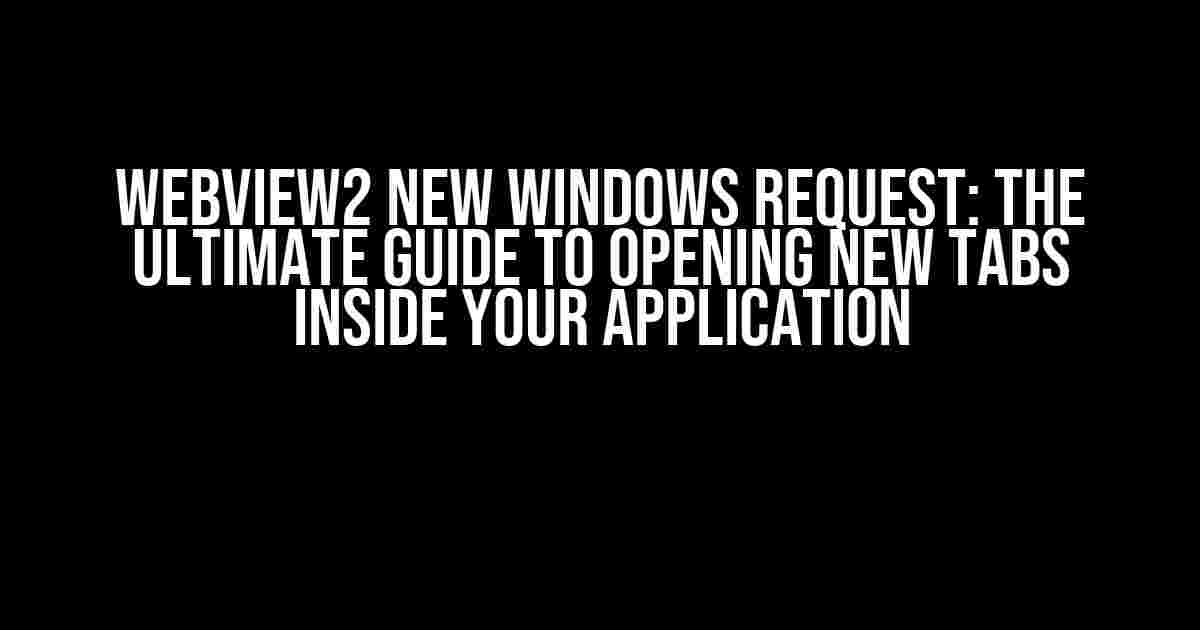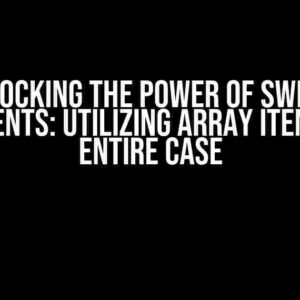Are you tired of WebView2’s default behavior of opening new windows in a separate browser instance? Do you want to provide a seamless user experience by opening new tabs inside your application instead? Look no further! In this comprehensive guide, we’ll take you through the steps to achieve just that.
Understanding the Problem
When a user clicks on a link or submits a form in a WebView2 control, the default behavior is to open a new window in a separate browser instance. This can be frustrating for users, especially in applications that require a seamless experience. Imagine a scenario where a user is working on a complex task and suddenly, a new browser window pops up, disrupting their workflow.
This is where the NewWindowRequested event comes in. This event is triggered when the WebView2 control needs to create a new window, and it’s up to us to decide how to handle it. In this article, we’ll explore how to capture this event and open new tabs inside our application instead of separate browser windows.
Capturing the NewWindowRequested Event
The first step is to capture the NewWindowRequested event in your WebView2 control. You can do this by adding an event handler to the CoreWebView2.NewWindowRequested event.
private void webView_NewWindowRequested(object sender, CoreWebView2NewWindowRequestedEventArgs e)
{
// Handle the event here
}In this example, we’ve added an event handler to the NewWindowRequested event. The e parameter provides information about the new window request, such as the URL and the window features.
Creating a New Tab
Now that we’ve captured the event, it’s time to create a new tab inside our application. We’ll create a new instance of the WebView2 control and add it to a tab control or a similar UI element.
private void webView_NewWindowRequested(object sender, CoreWebView2NewWindowRequestedEventArgs e)
{
// Create a new WebView2 control
CoreWebView2 newWebView = new CoreWebView2();
// Add the new WebView2 control to a tab control
TabItem newTab = new TabItem();
newTab.Content = newWebView;
tabs.AddTabItem(newTab);
// Set the initial URL
newWebView.Source = e.Uri;
}In this example, we’ve created a new instance of the WebView2 control and added it to a tab control. We’ve also set the initial URL of the new WebView2 control to the requested URL.
Handling Navigation
Now that we have a new tab, we need to handle navigation within the tab. We can do this by adding event handlers to the Navigating and NavigationCompleted events.
private void newWebView_Navigating(object sender, CoreWebView2NavigatingEventArgs e)
{
// Handle navigation
}
private void newWebView_NavigationCompleted(object sender, CoreWebView2NavigationCompletedEventArgs e)
{
// Handle navigation completion
}In these event handlers, you can perform tasks such as updating the tab title, displaying a loading indicator, or handling navigation errors.
Handling Window Features
When a new window is requested, the e parameter provides information about the window features, such as the width, height, and whether the window should be resizable. We can use this information to customize the new tab.
private void webView_NewWindowRequested(object sender, CoreWebView2NewWindowRequestedEventArgs e)
{
// Create a new WebView2 control
CoreWebView2 newWebView = new CoreWebView2();
// Set the initial width and height
newWebView.Width = e.WindowFeatures.Width;
newWebView.Height = e.WindowFeatures.Height;
// Set whether the window should be resizable
newWebView.Resizeable = e.WindowFeatures.Resizable;
}In this example, we’ve used the window features to set the initial width and height of the new WebView2 control and whether it should be resizable.
Common Scenarios
Here are some common scenarios to consider when opening new tabs inside your application:
| Scenario | Solution |
|---|---|
| Opening a new tab for a specific URL | Create a new WebView2 control and set the initial URL to the specified URL. |
| Opening a new tab for a popup window | Create a new WebView2 control and set the initial URL to the popup URL. You can also customize the window features, such as the width and height. |
| Opening a new tab for a file download | Create a new WebView2 control and set the initial URL to the download URL. You can also handle the file download by capturing the DownloadStarting event. |
Best Practices
Here are some best practices to keep in mind when opening new tabs inside your application:
- Use a consistent UI element for tabs, such as a tab control or a navigation menu.
- Provide a way for users to close tabs, such as a close button or a context menu.
- Handle navigation errors and provide a error page or a friendly error message.
- Use the window features to customize the new tab, such as setting the initial width and height.
- Consider using a separate thread or process for each tab to improve performance and stability.
Conclusion
In this article, we’ve explored how to open new tabs inside your application instead of separate browser windows when using WebView2. By capturing the NewWindowRequested event and creating a new WebView2 control, you can provide a seamless user experience and improve the overall usability of your application. Remember to handle navigation, window features, and common scenarios, and follow best practices to create a robust and user-friendly application.
By following the instructions and guidelines outlined in this article, you’ll be able to create an application that provides a seamless and integrated experience for your users. Happy coding!
Here are 5 Questions and Answers about “WebView2 New Windows Request should open new Tab inside the Application instead”:
Frequently Asked Question
Get the answers to your most pressing questions about WebView2 and new windows requests!
Q: Why do new windows requests in WebView2 open in a new browser window instead of a new tab in my application?
By default, WebView2 is designed to follow the user’s browser settings and behavior. However, we understand that this might not be the desired behavior for all applications. Luckily, there’s a way to configure WebView2 to open new windows requests in a new tab within your application!
Q: How can I make WebView2 open new windows requests in a new tab within my application?
You can achieve this by handling the NewWindowRequested event in your WebView2 instance. In this event handler, you can create a new tab in your application and navigate the new WebView2 instance to the requested URL. This way, you can keep the new window request within your application!
Q: Will this approach work for all types of new windows requests?
Almost! This approach will work for most new windows requests, such as those triggered by target="_blank" links or JavaScript code. However, some scenarios, like when the user clicks on a link with a specific protocol handler (e.g., mailto: or tel:), might still open in an external application. But for most cases, this solution should do the trick!
Q: Are there any performance implications when handling new windows requests in this way?
Handling new windows requests in a new tab within your application might introduce some performance implications, as it requires creating a new WebView2 instance and navigating to the requested URL. However, these implications should be minimal, and the benefits of keeping the user within your application usually outweigh the costs!
Q: Are there any security considerations when handling new windows requests in this way?
When handling new windows requests in a new tab within your application, you should ensure that your application properly sanitizes and validates any user input or URLs to prevent potential security vulnerabilities. Additionally, make sure to follow the same-origin policy and handle any errors or exceptions that might occur during the navigation process!



